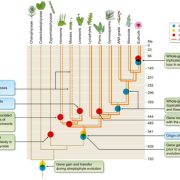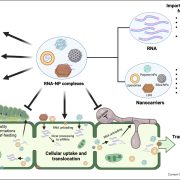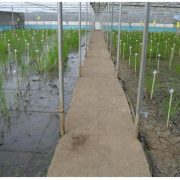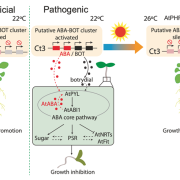
Review: Rapid auxin signaling: Unknowns old and new
Plant Science Research WeeklyYou might think you’ve read enough about auxin, but I recommend you take this opportunity to read one more article, this very interesting and enjoyable review by Fielder and Friml. Auxin has figured prominently in both the classical and molecular eras of plant biology. However, the exciting findings…

Review: Genome evolution in plants and the origins of innovation
Plant Science Research WeeklyLand plants have enormous diversity; however we do not fully understand how this has arisen. In this review article James Clark discusses how genome dynamics and gene loss contribute to genome evolution and the generation of diversity and complexity. He explains how genome evolution is non-homogenous…

Review: Improving RNA-based crop protection through nanotechnology and insights from cross-kingdom RNA trafficking
Plant Science Research WeeklyThe German physician Paul Ehrlich (not to be confused with the American scientist of the same name) coined the term “magic bullet” (zauberkugel) to describe something that is perfectly and accurately effective. As much as we dream of magic bullets, they are rarely found, but the idea of using spray-on…

Commentary: Time to fight the over-hype
Plant Science Research WeeklyA year ago, graduate student Merritt Khaipho-Burch Tweeted a reaction to an article about a gene described as enhancing yield, which led to lively on-line and in-the-lunchroom discussions about how to realistically measure yield, and, maybe more importantly, where to draw the line between potential and…

Microtubule-associated proteins regulate fruit shape in tomato
Plant Science Research WeeklyMicrotubule binding proteins are important in determining fruit shape by driving changes in microtubule arrangement. However, in depth molecular studies on these in tomato (Solanum lycopersicum) have been limited. Here, Bao et al. investigated the microtubule binding protein Microtubule-Associated Protein…

Oryza glumaepatula: A wild relative to improve drought tolerance in cultivated rice
Plant Science Research WeeklyWhen we speak about rice, we’re often referring to one of two domesticated species, Oryza japonica or Oryza indica. However, there are an additional 25 species in the genus Oryza. These so-called wild relatives harbor substantial genetic diversity that holds promise for crop improvement. Here, Prakash…

Bacterial pathogens deliver water- and solute-permeable channels to plant cells
Plant Science Research WeeklyWhat do you do when you’ve identified a gene that you know is important, but you don’t know how it functions? Usually, you can get hints from homology searches, overexpression studies, or the identification of protein domains, but sometimes those approaches don’t work. That’s where the story…

From friend to threat: the mutualist-pathogen transition of plant-fungal interaction is determined by a small gene cluster
Plant Science Research WeeklyThe infection modes of microbes in hosts can be reversible and can range from pathogenic to mutualistic, depending on the environmental conditions. The plant-associated fungus Colletotrichum tofieldiae (Ct) has been shown to promote primary root growth and increase shoot fresh weight of Arabidopsis in…

A large effect genetic trade-off is caused by a single mutation in CBF2
Plant Science Research WeeklyUnderstanding the genetic basis of local adaptation of a species is an important but thorny problem. Now that whole genomes are readily characterized, it’s not hard to see lots of differences between populations, but pulling meaning and demonstrating functional consequences out of those differences…

